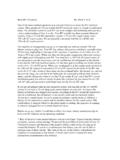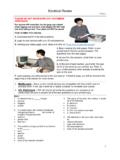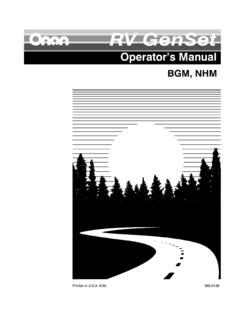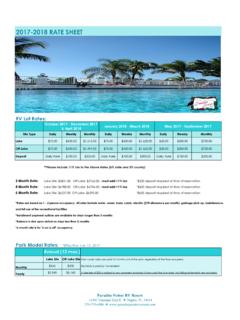Transcription of O w n e r ’s M A N U A L - KZ RV Sportsmen Classic ...
1 GUIDEBOOK TO ENJOYMENT OF YOUR KZRV, recreational vehicle Sportsmen Classic Owner s MANUAL PDF created with pdfFactory trial version OF CONTENTS Chapter 1 Introduction to RV Ownership .. 1 Safety 2 Reporting Safety Defects .. 2 Safety When Emergency Stopping .. 3 Additional Safety Considerations .. 3 Condensation .. 4 Chapter 2 Service Procedures .. 5 Basic Service Procedures .. 5 .. 6 .. 6 .. 6 Owner s Responsibility .. 6 Towable Limited Warranty .. 8 Chapter 3 Using Your RV .. 12 12 Tow vehicle .. 12 Hitches Travel Trailer .. 12 Hitch Height Specifications Travel Trailer .. 13 Hook-Up (Travel Trailer) .. 13 The Safety Chain (Travel Trailer) .. 14 .. 14 Weights .. 14 Weighing vehicle (Loaded or Unloaded) .. 15 Loading the Trailer 15 .. 16 Breakaway Switch .. 18 Fire Extinguisher .. 18 Setting Up and Using Your recreational vehicle .. 19 General Detector 20 Propane Detector .. 20 Smoke .. 23 Steps (Two or Three).
2 24 Windows .. 25 .. 25 TV Antennas (Standard Roof Mount) .. 25 Chapter 4 Systems .. 27 Water and Drainage Plumbing .. 27 .. 27 Filling Fresh Water System .. 27 12-Volt Demand Pump .. 28 .. 28 Bath and Shower .. 28 i PDF created with pdfFactory trial version Sanitizing and Filling the Potable Water System .. 29 Drainage (Fresh Water) .. 29 Sanitation System .. 30 .. 30 .. 31 Holding Tanks .. 31 Draining the Tanks .. 32 Maintenance for Holding Tanks .. 33 Winterizing Your recreational vehicle .. 33 Lo-Point Propane Fuel .. 36 Propane .. 36 Servicing and Filling Propane Containers .. 37 Installing Propane Containers .. 39 .. 40 High Pressure Hoses with Acme Connectors .. 41 Main Supply Hose Low Pressure .. 42 .. 42 Checking for 43 If You Smell Gas .. 43 Propane Gas Consumption .. 45 Electrical 46 General Information .. 46 Changes and Modifications .. 46 Power .. 46 Circuit Breakers and Box.
3 47 GFCI Protection .. 49 12 Volt DC System .. 49 .. 49 Auxiliary Battery .. 50 Circuit Breakers and Fuses .. 51 Exterior Lights and Connector (12V) .. 52 Porch .. 52 Brake .. 53 Chapter 5 54 .. 54 Operating Instructions .. 55 To Shut .. 55 Cooking .. 56 Operating Instructions .. 56 Water .. 57 Winterizing Your Water Heater .. 60 .. 60 .. 61 .. 61 ii PDF created with pdfFactory trial version Moisture Reduction Heater .. 61 Door .. 61 Door .. 62 Air Conditioning (Optional).. 62 iii PDF created with pdfFactory trial version CHAPTER 1 INTRODUCTION TO RV OWNERSHIP Welcome to the world of recreational vehicle travel. The purchase of your KZ product allows you to enter this type of camping and leisure travel. Your coach has been designed and engineered to offer many comforts of home. KZ recreational vehicles are designed and constructed to be used as temporary living quarters for camping and travel uses.
4 The coaches are not intended for hauling cargo. This owner s manual was prepared to assist you in understanding the proper use and operation of various containment systems, servicing and maintenance of component parts, and explanation of your warranty protection. If this is your first RV travel coach, you will want to acquaint yourself with all aspects and information found in this manual plus manuals supplied by component manufacturers. These materials will reflect the most current information available for the user. Some components and items may not be in your coach as they may be options on different models. Keep this owner s manual in your recreational vehicle for handy reference. Get to know your new vehicle and how it operates. You should carefully read and understand these instructions, as well as information supplied by the manufacturers of separately warranted products, since they contain important operating, safety, and maintenance instructions. If you have questions that are not adequately answered by this manual or other booklets, consult your dealer.
5 If he cannot satisfactorily answer your questions, he will call our staff for additional information. Every effort has been made to provide you with a safe, dependable product. Your vehicle complies with applicable requirements of Federal Motor vehicle Safety Standards, State Regulations, Canadian Standards Associations (CSA) where applicable, and complies with requirements of ANSI Standard , the nationally recognized Standard for recreational Vehicles Installation of Plumbing, Heating and Electrical Systems. The recreational vehicle Industry Association (RVIA) and Canadian Standards Association (CSA) periodically inspect our production lines and assist us in maintaining strict compliance with installation and safety standards for those systems. Your follow-up with periodic safety inspections and a program of preventive maintenance is important for the continuation of safe and trouble-free operation. PDF created with pdfFactory trial version Camping is a great way to relax and enjoy the outdoors with your friends and family.
6 Please remember to tread lightly on our beautiful land and leave only your footprints so that others may enjoy nature as much as you did. SAFETY CONSIDERATIONS The terms NOTE, CAUTION and WARNING have specific meanings in this manual as well as component manuals. A NOTE provides additional information to make a step or procedure easier or clearer. Disregarding a NOTE could cause inconvenience, but would not be likely to cause damage or personal injury. A CAUTION emphasizes areas where equipment damage could result. Disregarding a CAUTION could cause permanent mechanical damage. However, personal injury is unlikely. A WARNING emphasizes areas where personal injury or even death could result from failure to follow instructions properly. Mechanical damage may also occur. Reporting Safety Defects If you believe that your vehicle has a defect which could cause a crash or could cause injury or death, you should immediately inform the National Highway Traffic Safety Administration (NHTSA) in addition to notifying KZ.
7 If NHTSA in addition receives similar complaints, it may open an investigation, and if it finds that a safety defect exists in a group of vehicles, it may order a recall and remedy campaign. However, NHTSA cannot become involved in individual problems between you, your dealer or KZ. To contact NHTSA, you may either call the Auto Safety Hotline toll-free at 1-800-424-9393 or write to: NHTSA US Department of Transportation Washington, DC 20590 You can also obtain other information about motor vehicle safety from the Hotline. PDF created with pdfFactory trial version Safety When Emergency Stopping It is wise to carry road flags and/or triangular warning devices to be used when necessary. When pulling off a highway, use your four way hazard lights as warning flashers, even if only to change drivers. Pull off the road way completely if at all possible to change flat tires or any other emergency needs. Additional Safety Considerations 1. Sanitize the fresh water supply system periodically (see sanitizing instructions).
8 2. Keep water connection fittings from coming in contact with the ground or drain hose to reduce chance of contamination. 3. Enlist services of a qualified technician to fix gas or electrical appliances. 4. Always have a serviceable fire extinguisher placed in an easily accessible location. 5. Insure that tires are in good condition and properly inflated. Watch tire inflation closely. Under-inflated tires will overheat. Overheated tires are a potential hazard as they may throw rubber and cause a blow-out. Check the tire pressure before each trip while the tires are cold. 6. Check and tighten the wheel lugs regularly (every 50 miles when new until 200 miles are reached and then check the lugs every 500 miles). 7. Check the brakes in a safe area not while traveling a busy highway. 8. Always block the trailer wheels solidly before unhitching. 9. Before leaving a camp area with a trailer in tow, insure: a. The safety pin or locking lever is seated. b. The breakaway wire is attached to the tow vehicle .
9 C. All jacks are raised so that they cannot touch the ground. d. The 110-volt electrical cord is properly stored. e. The safety chains are connected. f. All interior lights are off. 10. Observe the warning labels attached to your vehicle concerning propane, water, electricity and loading. 11. Extinguish all campfires before leaving your campsite. PDF created with pdfFactory trial version CONDENSATION Where it comes from, what causes it, and various solutions. Causes: A. It occurs when warm moist air contacts a cold surface, such as rain touching a tent, awning fabric with people breathing warm moist air against it from inside due to normal breathing. B. When cooking food or taking a shower, warm moist air circulates thru out coach attaching itself to cooler surfaces, forming beads and running down wall or window C. Normal breathing will emit approximately 1/2 pint of moisture into the air per person, per day. The more occupants the greater quantity of condensation you may find.
10 Solutions: 1. When taking a shower, open bath roof vent approximately inch allowing moisture to escape. 2. Use the power vent over range when cooking. 3. If condensation is found in cabinet or closets, open door slightly to equalize temperature and provide ventilation. 4. Opening windows and roof vents, when possible, allowing warm moist air to escape is the best way to reduce condensation. 5. Under extreme conditions, you may need to use a dehumidifier to remove moist air conditions. In camping, coaches which have tents or fabric bunk areas, such as Coyote, it is even more important to avoid condensation drops from roof area. Opening the tent window at the person s head will allow air to flow across roof reducing or avoiding condensation. Uncontrolled condensation can cause dampness, mildew, etc., inside your recreational vehicle . Be sure to make strong efforts to control condensation. Continuous living in your recreational vehicle could cause accelerated wear to components above recreational use.




